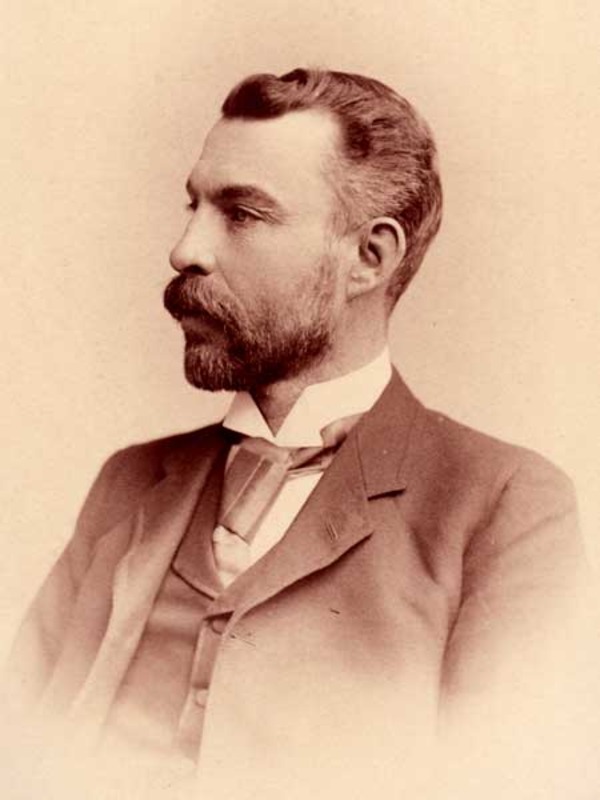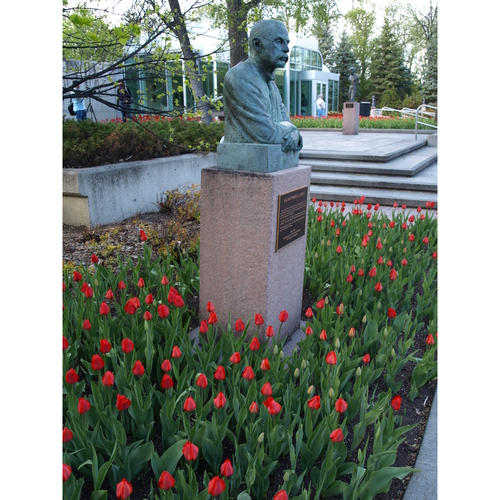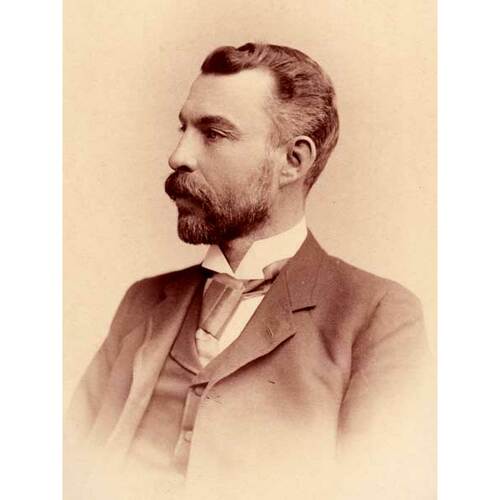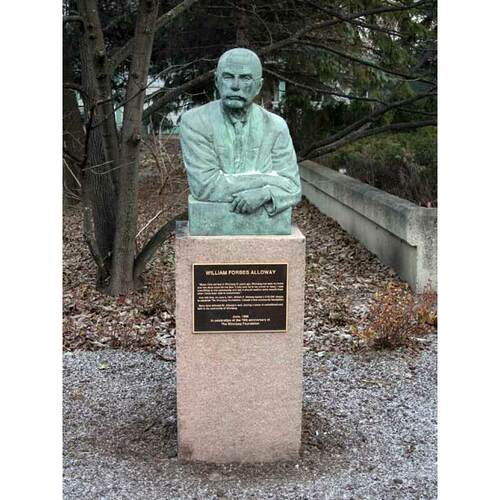
Source: Link
ALLOWAY, WILLIAM FORBES, businessman, politician, banker, and philanthropist; b. 20 Aug. 1852 in The Derries (Republic of Ireland), son of Arthur William Alloway, a veterinary surgeon, and Mary Frances Johnson; m. 3 Sept. 1878 Elizabeth MacLaren (d. 1926), daughter of James Maclaren*, in Buckingham, Que., and they had one son who died in infancy; d. 2 Feb. 1930 in Winnipeg.
In 1855, at age three, William Forbes Alloway immigrated to Hamilton, Upper Canada, with his family. There his father opened a veterinary surgery, a horseshoeing establishment, and a riding school. Less than two years later his father moved the family and business to Montreal, where William attended the High School of Montreal.
Four days after his 18th birthday, Alloway arrived in Winnipeg as a private in the expeditionary force under Colonel Garnet Joseph Wolseley* sent to quell the Métis uprising led by Louis Riel*. Subsequently he was among the 19 persons selected to form the nucleus of a mounted constabulary force for Manitoba. Discharged from the militia in April 1871, he settled in Winnipeg, where he was, like his father, a veterinarian, as well as a tobacconist and an auctioneer of horses. In 1874 he went to work as foreman for the well-known freighter and politician James McKay* and the following year became his partner in the transportation business.
In 1876 Alloway struck out on his own. For the next four years forwarding and trading occupied his attention. He speculated in land and scrip on the side. Alloway obtained most of his work from Thomas Nixon, purveyor for the Department of the Interior at Winnipeg, with whom he developed a rather cosy relationship as Nixon’s landlord. Later Nixon would be severely censured by a royal commission for his lack of diligence in business. On behalf of the dominion government, Alloway purchased horses for the surveying parties of the Canadian Pacific Railway. Buying principally from the Métis at the prevailing price of $50 for a good carthorse, he “reaped considerable advantage” by reselling them to the government at prices ranging on average from about $90 to $157. His enemies referred to him contemptuously as a “horse jockey.”
Alloway also provided the surveyors with the common “bushed and banded” native carts (so called because of the iron boxing around the axles and the bands on the hubs) and shamelessly lined his pockets further by engaging with Nixon in the resale of abandoned government carts and harnesses. At one time he used Nixon to help him raise money on their joint liability. Alloway’s questionable dealings with Nixon led to lucrative transportation contracts with the government, some of which were never advertised. He always subcontracted the work, which involved freighting supplies and carrying the mails to the construction crews of the CPR via the Dawson Road and Lake of the Woods, as well as supplying the various outposts of the North-West Mounted Police. Over the years his transactions with the government amounted to $40,000 or more.
Alloway’s business ambitions led him into local politics. He served four year-long terms on the municipal council in 1876–77 and 1879–80. He also sat on the first two councils of the reinvigorated Winnipeg Board of Trade, which finally became fully functional in 1879. Alloway had an unshakeable faith that the west must “fill up with people” and that Winnipeg must grow in “importance, size, wealth and prestige.” Photographs of him reveal a frank look and a fearless demeanour, characteristics which would earn him the respect and admiration of the business community in his efforts to help quicken the city’s commercial pulse.
On 28 Nov. 1879 Alloway formed a partnership in Winnipeg with Henry Thompson Champion, an accountant with the Merchants’ Bank of Canada, who had also come west with Wolseley’s expedition. They formalized their partnership in March 1880 as Alloway and Champion, “bankers, brokers, commission merchants, freighters, traders, and real estate agents.” The capital of the new firm was $7,000, of which Alloway contributed $5,000.
Starting in the unstable conditions incident to the building of the CPR, Alloway and Champion eschewed the real estate mania of 1881–82. As a private bank, the firm was free to deal in land and to lend money on its security, but the partners competed only for “legitimate business” rather than business connected with land speculation. Through Alloway’s foresight, the firm acquired a large inventory of “well selected farm lands” in every township in the province as well as in the North-West Territories which were sold “at reasonable prices and on easy terms.” The firm would also lend up to $25,000 on first mortgages.
By 1882 Alloway and Champion had increased its capital to some $175,000. About the same time, the firm became an agent for the CPR’s lands. To its work as a real estate agency, it later added payments for pre-emptions of federal lands and transactions for the Canada North-West Land Company [see William Bain Scarth*]. Most of its dealings in land, however, were done indirectly through the purchase and resale of land- and money-scrip, military bounty warrants, and tax sale certificates. The acquisition of scrip was greatly facilitated by William’s brother Charles Valentine, who would become a junior partner in the firm in 1885.
Alloway and Champion had opened in 1881 a branch in Portage la Prairie. That same year Alloway had become one of the founding directors of the Ogilvie Milling Company, the western subsidiary of A. W. Ogilvie and Company [see William Watson Ogilvie*]. In 1882 he helped establish the Manitoba Cartage and Warehousing Company and together with Champion and others he tried to organize a stock exchange. Although the exchange was not set up immediately because of the business collapse that spring, the firm soon turned its attention to the buying and selling of stocks on the Toronto, Montreal, New York, and Chicago exchanges. It also traded produce in the New York and Chicago markets.
In the early 1890s Alloway and Champion expanded its foreign exchange department to keep up with the demand of Manitoba’s rapidly growing immigrant population, mainly from eastern Europe, to convert its gold, silver, and national currencies into Canadian dollars and to remit funds abroad. By 1904 the exchange business had reached such a volume that the partners decided to establish a branch in Winnipeg’s north end. It opened the following year with five interpreters (later increased to ten). Acting generally as steamship and railway agents, Alloway and Champion helped to bring over many family members of those already established in the city. Alloway himself was extremely proud of the personal relationship which in large measure governed the branch’s business dealings with these new Canadians. This intimacy was expressed by one of its first employees, a Romanian Jew, who – commenting on the branch’s close connection with the Jewish community – fondly referred to it as the “Jewish Bank.”
During the boom years following the turn of the century, the firm became involved with the promotion of local industrial capital through Champion’s membership on the Winnipeg Stock Exchange, which opened in February 1909. Alloway and Champion’s astonishing success is evident in its financial strength: it rose to over $1,000,000 by 1912. That September the firm was incorporated as Alloway and Champion Limited with an authorized capital stock of $3,000,000 and a reserve of $125,000. The paid-up capital of $1,025,000 was mostly held by the original partners. Alloway and Champion had now become the largest and strongest private bank in the dominion. In 1919, three years after Champion’s death, Alloway sold the company to the Canadian Bank of Commerce, but he carried on as president until 1923. The business continued under the name Alloway and Champion Limited until his death in 1930.
The bank founded by William Forbes Alloway played an important role in the settlement and economic development of Manitoba and Winnipeg. Mindful, however, of the poverty and disadvantage wrought by unbridled growth, Alloway, a millionaire by 1910, was a generous supporter of many benevolent institutions through his annual contribution of $5,000 to the Federated Budget Board. He became a life governor of the Winnipeg General Hospital in 1884 and a member of its board of trustees from 1912 until his death. He was also a member for 25 years of the advisory board of the Margaret Scott Nursing Mission. His proudest achievement, however, was the incorporation in 1921 of Canada’s first community trust, the Winnipeg Foundation, which he endowed with an initial gift of $100,000. His wife, Elizabeth, took a deep interest in the foundation as well, and together their donations amounted to $2,654,764. The trust has been mentioned in the wills of numerous Manitobans and its impressive record of service in advancing human welfare and knowledge stands as Alloway’s abiding social testament.
ANQ-O, ZQ127/25, 3 sept. 1878. LAC, RG 9, II, A5, 3: 159; B4, 16: 1. Man., Dept. of Finance, Consumer and Corporate Affairs, Companies office (Winnipeg), Charter book A, 1880–90: 49–52, 144–45, 151–53; Letters patent, June–November 1912: 109; Partnership agreements, file no.83, 17 April 1880; file no.121, 3 April 1881. St John’s Anglican Cathedral (Winnipeg), Reg. of burials. Commercial (Winnipeg), 22 July 1889. Manitoba Free Press, 1873–1930, esp. 3 Feb. 1930. Winnipeg Tribune, 1 Nov. 1912. Can., House of Commons, Journals, 1878, app.1; Report of the Canadian Pacific Railway royal commission (3v., Ottawa, 1882). Canadian album (Cochrane and Hopkins), vol.3. N. S. Garland, Garland’s banks, bankers and banking in Canada . . . (Ottawa, 1890). Peter Lowe, “All western dollars,” Man., Hist. and Scientific Soc., Papers (Winnipeg), 3rd ser., no.2 (1945–46): 10–25. Helena Macvicar, Margaret Scott: a tribute; the Margaret Scott Nursing Mission ([Winnipeg, 1947?]).
Cite This Article
Peter Hanlon, “ALLOWAY, WILLIAM FORBES,” in Dictionary of Canadian Biography, vol. 15, University of Toronto/Université Laval, 2003–, accessed November 22, 2024, https://www.biographi.ca/en/bio/alloway_william_forbes_15E.html.
The citation above shows the format for footnotes and endnotes according to the Chicago manual of style (16th edition). Information to be used in other citation formats:
| Permalink: | https://www.biographi.ca/en/bio/alloway_william_forbes_15E.html |
| Author of Article: | Peter Hanlon |
| Title of Article: | ALLOWAY, WILLIAM FORBES |
| Publication Name: | Dictionary of Canadian Biography, vol. 15 |
| Publisher: | University of Toronto/Université Laval |
| Year of publication: | 2005 |
| Year of revision: | 2005 |
| Access Date: | November 22, 2024 |






